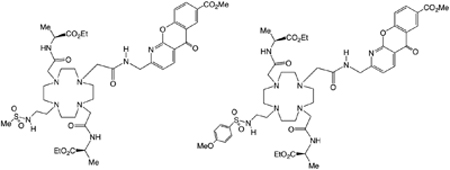Lysosomes are cellular organelles that contain enzymes which break down cellular waste, a bit like stomachs. They have an internal pH of 4.8 and maintain this acidic pH (compared to the cytosol, pH 7.2) by pumping protons across the membrane. Changes in lysosomal pH can indicate the onset of disease. In fact, elevated lysosomal pH has been noted in several lysosomal storage diseases. This group of around 50 rare, inherited, metabolic disorders result in symptoms such as seizures, deafness and/or blindness.
Now David Parker and colleagues at the University of Durham have designed responsive, low molecular weight probes which can permeate the target organelle and report the pH using a ratiometric signal. The probes could help evaluate the impact of drugs created to treat lysosomal storage diseases.
 The team made europium and terbium complexes of two structurally related ligands that contain a sulfonamide moiety which acts like a switch, reversibly binding to the lanthanide and changing the metal coordination environment. The change is signalled by variation of emission spectral form and relative intensity and also modulates the circular polarisation of luminescence as the local helicity at the metal centre switches.
The team made europium and terbium complexes of two structurally related ligands that contain a sulfonamide moiety which acts like a switch, reversibly binding to the lanthanide and changing the metal coordination environment. The change is signalled by variation of emission spectral form and relative intensity and also modulates the circular polarisation of luminescence as the local helicity at the metal centre switches.
Testing in a range of cell lines and altering the pH of the cellular and intracellular environment, the researchers developed an emission intensity ratio method using lanthanide luminescence which can be used to assess lysosomal pH variation for the first time.
Find out more by reading their ChemComm communication, free to download for a limited period.
Also of interest:
Times have changed since David Parker wrote his first ChemComm on a typewriter. He discusses his research path, chemical prostitution and targeted devastation in his ChemComm interview.










